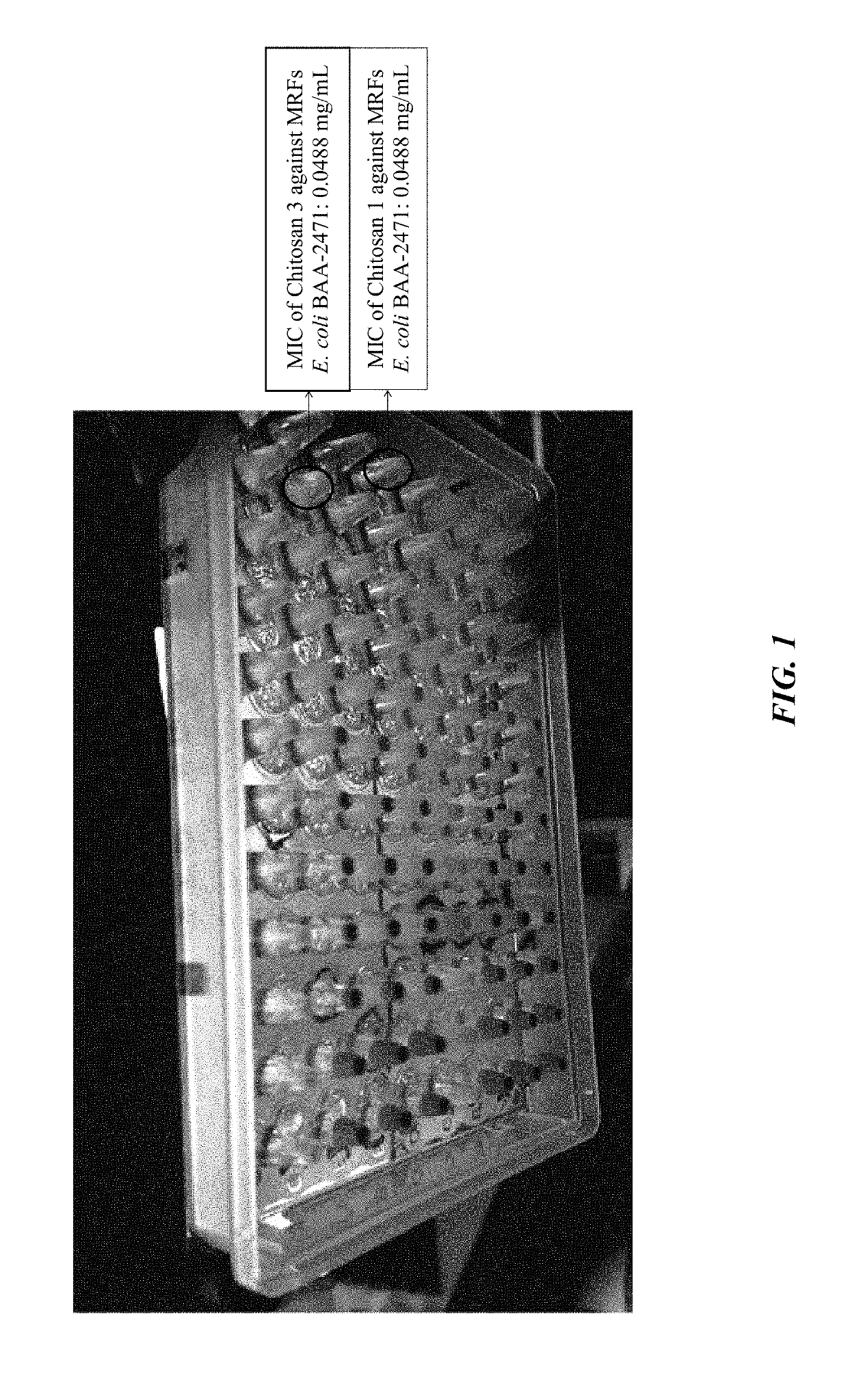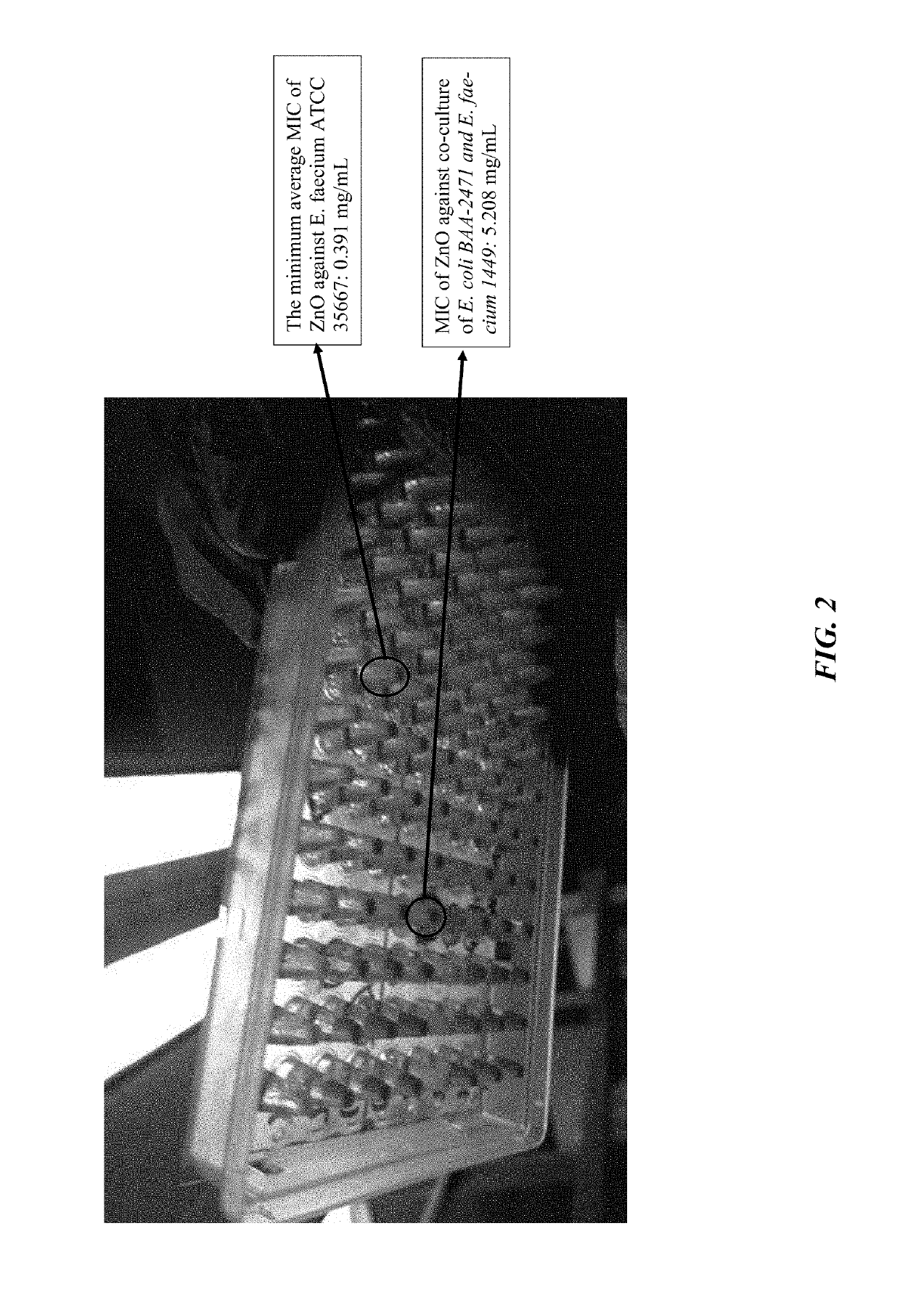Compositions for treating drug resistant bacteria and biofilm
a technology of drug resistant bacteria and biofilm, which is applied in the direction of antibacterial agents, microcapsules, capsule delivery, etc., can solve the problems of compromising the lives affecting the survival rate of the most immunocompromised populations, and the use of i>e. faecium /i>as a fermentative strain is questionabl
- Summary
- Abstract
- Description
- Claims
- Application Information
AI Technical Summary
Benefits of technology
Problems solved by technology
Method used
Image
Examples
experiment / study 1 (
Experiment / Study 1 (Mitigation of Drug Resistant Bacteria)
[0070]The nosocomial MRF, Gram-negative-Escherichia coli, and Gram-positive-Enterococcus faecium are of prime concern to public health safety. This study was performed to examine effectiveness of a natural nanomicelle-based chitosan having different molecular weight and non-toxic ZnO combination to treat these MRF strains in vitro and in vivo. Herein, the antimicrobial effects of nanoparticles (NPs) of chitosan alone, ZnO alone, and chitosan and ZnO (CZNPs) in combination at 1:1 were examined on co-cultured MRFs through the MIC test according to National Committee for Clinical Laboratory Standards (NCCLS). To improve the stability and activity of CZNPs, a carrier system was initially developed comprising PEG-functionalized phospholipid micelles, using either gadolnium oxide in core and MnO with Dox in the core along with the DNA and chitosan on shell.
[0071]Results indicated that chitosan (C1 and C2) alone was ineffective at a...
experiment / study 2 (
Experiment / Study 2 (Nanotherapeutics for Mutating Multi-Drug Resistant Fecal Bacteria)
[0084]The current study was performed to test efficacy of a natural antimicrobial, polymeric chitosan-based nanoparticles combined with ZnO to in situ intervention. Herein, the effects of NPs of chitosan, ZnO alone, and a combination of chitosan and ZnO (CZNPs) at 1:1 were examined on co-cultured nosocomial MRFs and a wild type (WT) through the MIC test conform to National Standards, NCCLS. To elucidate visually the mechanistic effects of NPs alone and CZNPs on MRF and WT strains, Transmission Electronic Microscopy (TEM) was performed. While chitosan 1 (C1) and 2 (C2) alone with a molecular weight of 3 kDa and 50 kDa, respectively inhibited resistant E. coli strain (E. coli BAA-2471), they were ineffective at a concentration less than 5 mg / mL on either E. faecium strains and the co-cultures. ZnO and chitosan alone did not exhibit optimal effects on MRF strains and cultures alone. However, the MRF c...
experiment / study 3 (
Experiment / Study 3 (Molecular Identification and Nanoremediation of Lytic Biofilm in Algal Systems using Untreated Wastewater)
[0107]Wastewater-algal biomass is a promising option for algae cultivation, which may be used for biofuel production. However, multidrug resistant biofilm constitutes a medium to potential infection in algal cultivation workers. An objective of the current study was to develop a comprehensive screening of the most prevalent bacterial consortia found in biofuel reactors and study the effectiveness of CZNPs against such harmful bacteria.
[0108]The synergistic application of chitosan oligomers with ZnO nanoparticles showed promise for a method that utilizes low molecular weight chitosan derivatives with the increased surface area of ZnO nanoparticles. The notable antimicrobial properties of ZnO are optimized by the use of chitosan oligomers that contain transcellular properties to cross cellular membranes and its structural ability to bond to metal oxide compound...
PUM
| Property | Measurement | Unit |
|---|---|---|
| molecular weight | aaaaa | aaaaa |
| molecular weight | aaaaa | aaaaa |
| molecular weight | aaaaa | aaaaa |
Abstract
Description
Claims
Application Information
 Login to View More
Login to View More - R&D
- Intellectual Property
- Life Sciences
- Materials
- Tech Scout
- Unparalleled Data Quality
- Higher Quality Content
- 60% Fewer Hallucinations
Browse by: Latest US Patents, China's latest patents, Technical Efficacy Thesaurus, Application Domain, Technology Topic, Popular Technical Reports.
© 2025 PatSnap. All rights reserved.Legal|Privacy policy|Modern Slavery Act Transparency Statement|Sitemap|About US| Contact US: help@patsnap.com



